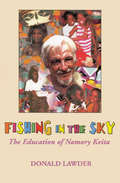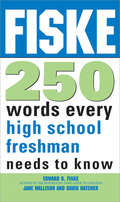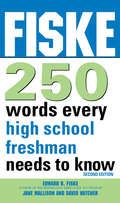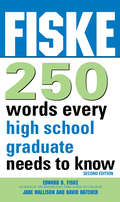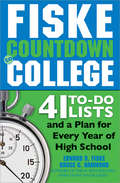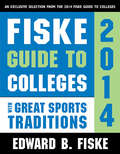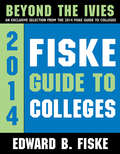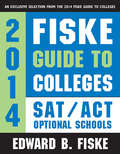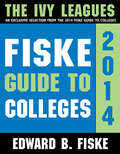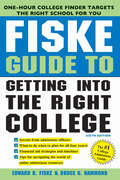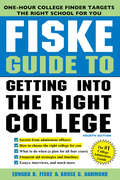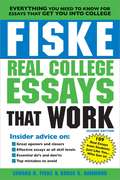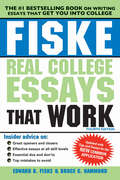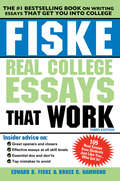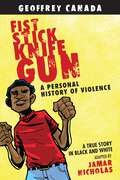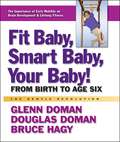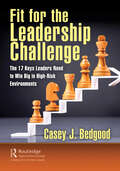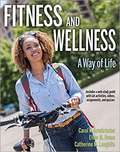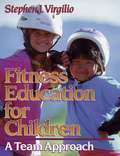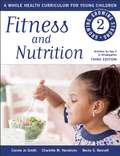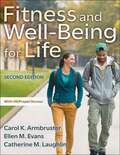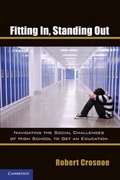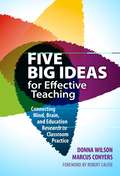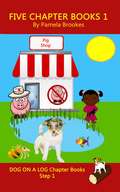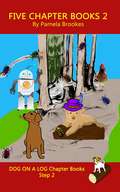- Table View
- List View
Fishing in the Sky: The Education of Namory Keita
by Donald LawderWhat distinguishes this remarkable narrative from other accounts of personal growth is not just its vivid and intimate picture of West African life, but the fact that its author embarked on his adventure at an age when most men and women are resigned to life in a rocking chair. At age sixty-six, after the break-up of a stormy marriage, Donald Lawder begins a new life as a volunteer teacher for the Peace Corps in the impoverished country of Mali, in West Africa. He is adopted by a Moslem family, given a Malian name, and learns to pray in the village mosque. As "Professor of English" at the state teacher's college in Mali's capital city of Bamako, he teaches Debate, Black American History, and the philosophy of Emerson and Thoreau to French-speaking African students and becomes deeply involved with a Moslem student less than one third his age. Later, after a two-year job hunt in the U.S. convinces him that America is no country for old men, he returns to Bamako for good, as chief of an African family of six children ranging in age from three to twenty-three years. He arrives in time to witness his unarmed students' heroic overthrow of the brutal dictator Moussa Traore and their confused efforts to establish one of the first democracies in West Africa. An intimate and moving account of modern Africa in turmoil and of an old man's discovery of love in one of the poorest countries of the world.
Fiske 250 Words Every High School Freshman Needs to Know
by Jane Mallison Edward B. Fiske David HatcherStarting off with a powerful vocabulary is the best way to prepare for a successful, stress-free time in high school. High school opens a world of new ideas and experiences-along with more challenging and sophisticated concepts. Knowing these 250 words will give students the gift of a head start that will last for years to come. Every year, thousands of families trust Edward Fiske, author of the #1 bestselling Fiske Guide to Colleges and the former education editor of the New York Times , as their guide for honest advice on creating the best educational experience possible-because he knows and listens to students. Together with vocabulary experts Jane Mallison and David Hatcher, Fiske 250 Words Every High School Freshman Needs to Know gives students the most important words they'll encounter in high school, across a wide range of subjects and skill levels. This short, powerful tool will allow any student to expand his vocabulary, sharpen his writing skills, and be prepared to make the most of his high school years!
Fiske 250 Words Every High School Freshman Needs to Know (2nd edition)
by Edward FiskeHere are the 250 most important words students need to know to be successful in high school and beyond, from the former education editor of the New York Times and a leading educational authority. Each entry contains a complete definition, word origin, and example sentences, making it both the perfect gift for eighth grade graduation and an effective tool for expanding a student's vocabulary, preparing them for standardized tests, and increasing their writing skills. This is the perfect book for giving students who are entering high school a clear advantage before they begin.
Fiske 250 Words Every High School Graduate Needs to Know 2E
by Jane Mallison Edward B. Fiske Dave HatcherHere are the 250 most important words students need to know to be successful in college and beyond, from the former education editor of the New York Times and a leading authority on college admissions. Each entry contains information on the word origin, a complete definition, and example sentences, making it both the perfect gift for high school graduation and an effective tool for expanding a student's vocabulary, increasing word comprehension, and honing their writing skills. This is the perfect book for giving young adults entering college or starting a career a clear advantage before they begin.
Fiske Countdown to College
by Edward B. Fiske Bruce G. HammondUnique, simple approach to the complicated college prep process, from the leading authority in college admissions.
Fiske Guide to Colleges with Great Sports Traditions
by Edward FiskeBlue and white face paint at Duke; the Big Brown Jug trophy game between Minnesota and Michigan; touchdown Jesus at Notre Dame--American colleges and universities are packed with sports traditions that date long before the first telecast of ESPN. Now, the preeminent name in college guides, Edward B. Fiske, turns his pen to those schools that bleed their mascot colors. Whether a grand old favorite-Auburn anyone?--or a surprising addition-University of Pennsylvania--you'll be fascinated by the details Fiske brings to these sports infused schools.
Fiske Guide to Colleges: Beyond the Ivies
by Edward B FiskeWhen it comes to academic excellence, the Ivy Leagues aren't the only schools worth their salt. And nobody knows that better than Edward B. Fiske. Beyond the Ivies introduces an exclusively selected sample from the 2014 Guide to Colleges of ten schools that have redefined what it means to be a top university. From leading engineering institutions to small liberal arts colleges, discover which of these academic elites fits your needs the most! Includes:-Full-color photos-Full-color infographics-Links to school websites-Links to admission email addresses
Fiske Guide to Colleges: SAT/ACT Optional Schools
by Edward B FiskeApplying for college is a stressful endeavor: choosing the right schools, paying application fees, and writing personal essays. But, before you can even get to those steps you're faced with the prospect of taking the SAT or ACT-two of the most daunting tests of a young person's life. Maybe you're not a good test-taker, or you freeze under pressure, causing your score to plummet-what do you do now? Are you hopes of getting into a good college dashed forever? The answer is unequivocally no-you can attend a great college even if your SAT or ACT scores are lacking. Edward B. Fiske-the author of the most trusted college guide on the market-has compiled a collection of SAT/ACT optional schools. Though these schools may not require test scores, they still deliver a high quality education. Included: -14 high quality SAT/ACT optional schools -Full Fiske write ups and descriptions -Color photographs -Statistics on every school
Fiske Guide to Colleges: The Ivy Leagues
by Edward B. FiskeEver wonder what it would be like to walk the corridors of Benjamin Franklin's university? Or to study in the same library as countless Nobel laureates? Take an in-depth look at the history and prestige of the most well-known and elite universities in the nation-the Ivy Leagues. With this exclusive sample from the Fiske Guide to Colleges 2014, you can uncover the traditions behind the prestigious reputations and discover which of these academic elites would be the best fit for you. Includes:-Full-color photos-Full-color infographics-Links to school websites-Links to admission email addresses
Fiske Guide to Getting Into the Right College
by Edward Fiske Bruce Hammond"An exceptionally useful overview for the college bound."--BooklistGet Accepted to the College That's Right For You Getting into college can be stressful. It's hard enough to find your dream school, but you need to navigate the admissions process too! Never fear. With advice from the two leading college admission experts, the Fiske Guide to Getting Into the Right College will help you generate a list of schools you love and walk you step-by-step through the process of applying to them.The most trusted experts in America's colleges will show you how to: Discover which schools are right for you based on academic programs, size, location, institutional culture, and more Wrap your head around standardized tests Write compelling essays (even if you're not a great writer) Show off your best features in your application Ask the right questions during campus visits Understand how admissions officers rank candidates Gets off the wait list and into the college of your dreams Attract and negotiate the best financial aid packageThe most trusted resource for helping students get into the schools of their choice.
Fiske Guide to Getting into the Right College
by Edward B. Fiske Bruce G. HammondGet accepted to the college that's right for you. Everyone has their own idea of the perfect college. The Fiske Guide to Getting into the Right College is the only admissions guide that starts with an in-depth assessment of your priorities, then takes you step-by-step through the process of applying to the schools you actually want to get into. The #1 expert on America's colleges will show you how to:Choose the right kind of school for you, Filter out the hype, Earn the test scores colleges want to see, Write authentic essays (even if you're not a great writer, Submit an application that shows off your best features, Ask the right questions during campus visits, Know how admissions officers rank candidates, Get off the waiting list and get accepted, and Attract and even negotiate the best financial aid package. The most trusted resource for helping students get into the schools of their choice. Edward B. Fiske served for seventeen years as education editor of the New York Times, during which time he realized that college-bound students and their families needed better information on which to base their educational choices. He writes the bestselling annual Fiske Guide to Colleges to help them. Bruce G. Hammond has devoted much of his time to counseling for college. He served as managing editor of the Fiske Guide to Colleges and is director of college counseling at Dipont Education Management. He has been quoted in numerous publications, including the New York Times, the Wall Street Journal,and U. S. News & World Report.
Fiske Real College Essays That Work
by Edward B. Fiske Bruce G. HammondThe #1 book on college admissions essays, completely updated and revised From the most trusted name in college admissions, Fiske Real College Essays That Work is the first application essay book designed for those who need it most: bright students who aren't natural writers. College experts Edward Fiske and Bruce Hammond offer readers the best, most student-tailored advice on how to choose their topic and write their essay. Students can learn by example with more than 100 real sample essays, chosen from all degrees of writing proficiency, including 20 brand-new essays from students who got into the most up-and-coming, in-demand schools. Examples are also given to show how an essay is edited from initial to final draft. Fiske and Hammond give students an all-inclusive guide to writing an application essay that will open the door to the college of their dreams.
Fiske Real College Essays That Work
by Edward Fiske Bruce HammondTop College Essays That Show You What Works1. Take the stress out of writing your essays!Every fall, thousands of aspiring students just like you spend hours staring at a computer screen, searching for a clever opening line or life-changing experience. It doesn't have to be that hard--we'll help you push past writer's block and find a topic that works for you!2. Let your personality shine through!A good essay does not need to be a literary masterpiece or a scholarly treatise worthy of James Joyce. The best essays come from high school students just being themselves. We'll teach you how to showcase yourself--and all the depth, with, charm, and quirkiness you bring to your daily life.3. Submit an essay that will get you in!College admissions experts Edward B. Fiske and Bruce G. Hammond give you all the advice you need for an essay that will open the door to the college of your choice. You'll find effective examples from real applicants--of all skill levels--and learn how to successfully bring your essay from initial draft to final submission.Real essays on these topics and more: Athletics The Arts Racial and Cultural Differences Humor Family Personal Growth Travel
Fiske Real College Essays that Work 3E
by Edward B. Fiske Bruce G. HammondFrom the most trusted name in college admission resources comes the first application–essay book designed for those who need it most–bright students who aren't natural writers. By providing more than 100 real sample essays, college experts Edward Fiske and Bruce Hammond give students an all–inclusive guide to writing an application essay that will open the door to the college of their choice. Includes samples written with all degrees of proficiency and describes how to edit an essay, from initial draft to final submission.
Fist Stick Knife Gun: A Personal History of Violence
by Geoffrey CanadaLong before U.S. News and World Report named him one of America's Best Leaders and Oprah Winfrey called him "an angel from God," Geoffrey Canada was a small, vulnerable, scared boy growing up in the South Bronx. Canada's world was one where "sidewalk" boys learned the codes of the block and were ranked through the rituals of fist, stick, and knife. Then the streets changed, and the stakes got even higher. In this candid and riveting memoir, Canada relives a childhood in which violence stalked every street corner. "If you wonder how a fourteen-year-old can shoot another child his own age in the head and then go home to dinner," Canada writes, "you need to know you don't get there in a day, or week, or month. It takes years of preparation to be willing to commit murder, to be willing to kill or die for a corner, a color, or a leather jacket."
Fit Baby, Smart Baby, Your Baby!
by Glenn Doman Douglas Doman Bruce HagyThe early development of mobility in newborns is a vital part of their future ability to learn and grow to full potential. We may be wasting our children's most important years by preventing them from physically exploring their world and maximizing their mobility development when they are young-the time that is is easiest for them to do so. In Fit, Baby, Smart Baby, Your Baby!, Glenn Doman-founder of The Institutes for the Achievement of Human Potential-along with Douglas Doman and Bruce Hagy guide you in maximizing your child's physical capabilities. They clearly explain each stage of mobility and show how to create an enviroment that will help your baby more easily achieve that stage. Full-color charts, photographs, illustrations, and detailed yet easy-to-follow instructions are included to help you create an effective home program.This inspiring book shows how the team of mother, father, and baby can explore and discover together the joys of human mobility. From learning the simple but vital stage of crawling to the beginnings of the sophisticated skills of the gymnast, this athletic team is the one that's most important to baby.
Fit for the Leadership Challenge: The 17 Keys Leaders Need to Win Big in High-Risk Environments
by Casey J. BedgoodThe key to effective leadership is being fit for the challenge. Leadership is a perpetual boxing match in many respects in which preparation, stamina and skill are required. Only the strongest survive. Every decision and tollgate along the career journey is laden with risk. Those leaders who harness risk to their advantage will land the knockout punch in every fight. The only question is how many leaders will be fit enough for the challenge? The purpose of this book is to provide insight as to how risk impacts every aspect of leadership, including the mundane, routine and nonglamorous aspects of leadership. This is important because often the small things can easily turn into big disruptors. Moreover, the end goal is to equip leaders with a journey map and quick guide to win in high-risk environments. Change is the new normal and only constant in today’s world. As change increases, so will risk and its subsequent impacts on humanity. This includes leaders, organizations and customers. No one is exempt. In this book, readers learn how to: Determine which career battles to fight and which ones to avoid Prepare to fight the unavoidable challenges along the career journey Leverage risk to choose the right leaders for the team Leverage risk to invest time wisely and avoid wasting it Leverage risk to predict, identify and resolve leadership burnout Risk assess leadership credentials so only those that produce a return are added to the portfolio Risk assess performance outcomes so the path ahead is smooth sailing instead of a rough ride Leverage risk so high performance is a reality instead of a pipe dream Leverage risk to find the right leadership sponsor
Fitness And Wellness: A Way Of Life
by Carol K. Armbruster Ellen M. Evans Catherine M. Sherwood-LaughlinWith content targeted specifically toward the college-age population, Fitness and Wellness: A Way of Life With Web Study Guide presents evidence-based physical and mental health guidance to point students toward healthy choices that will develop into healthy lifestyles. Authors Carol K. Armbruster, Ellen M. Evans, and Catherine M. Laughlin have more than 80 years of combined health and wellness professional experience, the majority of which has focused on the college population. This enables them to present the material in a contemporary manner that is easily relatable and understood by students. Relevant information on topics such as cardiovascular exercise, strength training, stretching, nutrition, weight management, stress management, substance abuse and addiction, and sexual health will start students on the path to developing a healthy mind and body, which can lead to a better quality of life. Additionally, because Fitness and Wellness: A Way of Life emphasizes behavior modification to develop desired habits, students are armed with the tools they need to make healthy lifestyle changes—for both the present and future: • A web study guide offers 48 video clips and practical learning activities to provide real-life context to the material • Behavior Check sidebars help students integrate health and wellness concepts into their daily lives • Now and Later sidebars encourage students to consider how their actions today will affect them in the future • The Functional Movement Training section shows exercises to strengthen specific muscles and explains their importance for common activities • Infographics, evidence-based tables, and figures illustrate and reinforce key concepts so they are easy to understand The companion web study guide offers students the unique opportunity to engage directly with the content and practice the exercises and strategies presented. Lab activities for each chapter will guide students in completing individual assessments, setting goals, and identifying the pros and cons of modifying their behavior. Video clips of 48 exercises demonstrate proper exercise technique, and additional learning activities and quizzes gauge student comprehension of the content. In addition, students will benefit from learning aids such as key terms, a glossary, and review questions for each chapter. Instructors will benefit from an abundance of online ancillaries: a presentation package plus image bank, test package, chapter quizzes, and an instructor guide that includes chapter summaries, chapter objectives, class outlines, sample answers to the chapter review questions, and suggested class project activities. The primary goal of Fitness and Wellness: A Way of Life is to provide a personal, evidence-based tool to help students embrace living well. They will learn how to make healthy choices and positive behavior changes to lead and sustain healthier, happier, and more productive lives, now and in the future.
Fitness Education for Children
by Stephen J. VirgilioThe complete guide to developing a fitness education program at the elementary school level
Fitness and Nutrition
by Becky S. Bennett Connie Jo Smith Charlotte M. HendricksDuring the preschool and kindergarten years, children begin spending more time engaging in physical activity and exploring new foods. Help children learn how to take care of their bodies as they build a foundation for healthy, active lives with this Fitness and Nutrition curriculum. Children will learn about motor development, fitness and physical activity, rest and relaxation, food choices and eating habits, and avoiding germs when eating.The curriculum includesOverviews of the six fitness and nutrition topicsSuggested interest area materials and supports for creating the learning environmentLearning objectives and vocabulary words to introduce and useSuggestions for evaluating children's understanding of each topicMore than 30 hands-on classroom activitiesFamily information and take-home activitiesThis book is part of the Growing, Growing Strong series, a whole-health curriculum for children age three though kindergarten. Together, the books provide a complete set of activities and resources to help you support children's growth and wellness.
Fitness and Well-Being for Life
by Carol K. Armbruster Ellen M. Evans Catherine M. LaughlinFitness and Well-Being for Life, Second Edition With HKPropel Access, provides a personal and interactive tool for college students to learn how to lead and sustain lives that are healthier, happier, and more productive. Evidence-based physical and mental health guidance is presented in an accessible writing style and organized in a logical progression, resulting in a text easily relatable to and understood by college students. With an emphasis on behavior modification to develop long-term health habits, challenges specific to college students are addressed, including stress management, substance abuse and addiction, sexual health, weight management, cardiovascular exercise, strength training, functional fitness training, and nutrition. Students will be equipped with the understanding and tools to make lifestyle changes that matter. Related learning aids, delivered through HKPropel, include 48 video clips demonstrating proper movement technique. A fitness testing video, new to this edition, helps students visually see and understand how to conduct personal fitness tests. Also new to this edition are video demonstrations of two sample workouts, one with total body movements that target small and weak muscle groups and one with upper-body exercises using resistance bands. These sample workouts serve as examples for students to learn how to structure their own workouts. Practical learning activities, assignable by instructors in HKPropel, provide real-life context and personal application of the material, focusing on completing individual assessments, goal setting, and identifying the pros and cons of modifying their behavior. Comprehension of the content is gauged through automatically graded chapter quizzes assigned and tracked by instructors within HKPropel. Within the book, pedagogical aids and practical tips promote understanding and application to daily life, including Immunity Booster tips with practical advice for staying healthy, Behavior Check sidebars to help students integrate concepts, and Now and Later sidebars that encourage students to consider how actions today will affect their future. A Functional Fitness Training insert provides movements to strengthen key muscles and explains their relevance to common activities, while infographics, tables, and figures throughout illustrate and reinforce key concepts in an easy-to-understand manner. Fitness and Well-Being for Life, Second Edition With HKPropel Access, helps students learn how to make healthy choices and enact positive behavior changes to lead healthier and happier lives both now and in the future.
Fitting In, Standing Out
by Robert CrosnoeIn American high schools, teenagers must navigate complex youth cultures that often prize being 'real' while punishing difference. Adults may view such social turbulence as a timeless, ultimately harmless rite of passage, but changes in American society are intensifying this rite and allowing its effects to cascade into adulthood. Integrating national statistics with interviews and observations from a single school, this book explores this phenomenon. It makes the case that recent macro-level trends, such as economic restructuring and technological change, mean that the social dynamics of high school can disrupt educational trajectories after high school; it looks at teenagers who do not fit in socially at school - including many who are obese or gay - to illustrate this phenomenon; and it crafts recommendations for parents, teachers and policy-makers about how to protect teenagers in trouble. The result is a story of adolescence that hits home with anyone who remembers high school.
Five Big Ideas for Effective Teaching: Connecting Mind, Brain, and Education Research to Classroom Practice
by Donna Wilson Marcus ConyersAs the 21st century ushers in the era of Common Core State Standards, the goal of teaching expands from a basic transmission of facts to the development of cognitive skills that equip students to achieve more of their unique potential. This seminal book focuses on five essential concepts from neuroeducation that should underlie all teaching decisions: (1) neuroplasticity, findings that the structure and function of the brain change in response to learning; (2) potential, the capacity for all students to make learning gains; (3) malleable intelligence, which stands in opposition to traditional views of fixed intellect; (4) the Body-Brain System, the role of physical fitness, healthy nutrition, and positive emotions in facilitating learning; and (5) metacognition, teaching students to "think about their thinking". To support classroom implemenation, these discussions include vignettes, examples, teaching strategies, reflective questions, and connections between brain-based learning principles and the Common Core. The text concludes by unmasking myths and misconceptions that may obscure these core concepts.
Five Chapter Books 1: Decodable Books for Phonics Readers and Dyslexia/Dyslexic Learners (DOG ON A LOG Chapter Book Collection #Volume 1)
by Pamela BrookesDecodable Chapter Books for Phonics Readers and folks with a Dyslexic Learning Style <P><P>This collection is the five books in Step 1 of the DOG ON A LOG Chapter book series. <P><P>The books are: The Dog On The Log</br> The Pig Hat</br> Chad The Cat</br> Zip The Bug</br> The Fish and The Pig <P><P>Individual books can also be purchased separately. <P><P>Sight Words:</br> a, are, be, does, go, goes, has, he, her, his, into, is, like, my, of, OK, says, see, she, the, they, to, want, you <P><P>Each book has about 260 to 470 total words <P><P>These are Step 1 Chapter books. <P><P>The DOG ON A LOG Books series are for phonics readers and folks with a dyslexic learning style. The words used reflect the inclusion of 1 to 3 new phonics rules in each step. There are five books at each step. <P><P>The chapter books are written in a chapter format with one picture in most chapters. They are longer, have more detail, and sometimes offer more complexity than the Let’s GO! Books. They’re great for practicing known and new phonics rules. They’re also just fun reading. <P><P>DOG ON A LOG Let’s GO! Books are shorter versions of DOG ON A LOG Chapter books. Let’s GO! books tell the same stories with about 8 pictures and only a few sentences per page. They’re perfect as an introduction to the new phonics rules or simply for fun reading for younger kids. <P><P>DOG ON A LOG Phonics Progression <P><P>Step 1: Consonants, primary sounds Short vowels Digraphs: ch, sh, th, wh, ck 2 and 3 sound words Possessive ‘s <P><P>Step 2: Bonus letters (f, l, s, z after short vowel) “all” –s suffix <P><P>Step 3: ang, ing, ong, ung, ank, ink, onk, unk <P><P>Step 4: Consonant Blends to make 4 sound words 3 and 4 sound words ending in –lk, -sk <P><P>Step 5: Digraph blends –nch to make 3 and 4 sound words Silent e, including "-ke" <P><P>Step 6: ild, old, olt, ind, ost <P><P>Step 7: 5 sounds in a closed syllable word plus suffix -s (crunch, slumps) 3 letter blends and up to 6 sounds in a closed syllable word (script, spring) <P><P>Step 8: Two syllable words with 2 closed syllables, not blends (sunset, chicken, unfit) <P><P>WATCH FOR MORE STEPS AND BOOKS COMING SOON <P><P>For information on upcoming books see dogonalogbooks.com or visit our Facebook page.
Five Chapter Books 2: Decodable Books for Phonics Readers and Dyslexia/Dyslexic Learners (DOG ON A LOG Chapter Book Collections #Volume 2)
by Pamela BrookesDecodable Chapter Books for Phonics Readers and folks with a Dyslexic Learning Style. <P><P>This collection is the five books in Step 2 of the DOG ON A LOG Chapter book series. <P><P>The books are: <P><P>Mud On The Path</br> The Red Hen</br> The Hat And Bug Shop</br> Babs The ‘Bot</br> The Cub <P><P>Individual books can also be purchased separately. <P><P>Sight Words: </br> a, are, be, could, do, does, eggs, for, from, go, goes, has, have, he, her, here, his, I, into, is, like, likes, me, my, nest, of, OK, onto, or, puts, said, say, says, see, sees, she, should, the, they, to, want, wants, was, we, what, when, would, you, your <P><P>Each book has about 550 to 1,000 total words <P><P>These are Step 2 Chapter books. <P><P>The DOG ON A LOG Books series are for phonics readers and folks with a dyslexic learning style. The words used reflect the inclusion of 1 to 3 new phonics rules in each step. There are five books at each step. <P><P>The chapter books are written in a chapter format with one picture in most chapters. They are longer, have more detail, and sometimes offer more complexity than the Let’s GO! Books. They’re great for practicing known and new phonics rules. They’re also just fun reading. <P><P>DOG ON A LOG Let’s GO! Books are shorter versions of DOG ON A LOG Chapter books. Let’s GO! books tell the same stories with about 8 pictures and only a few sentences per page. They’re perfect as an introduction to the new phonics rules or simply for fun reading for younger kids. <P><P>DOG ON A LOG Phonics Progression <P><P>Step 1: Consonants, primary sounds Short vowels Digraphs: ch, sh, th, wh, ck 2 and 3 sound words Possessive ‘s <P><P>Step 2: Bonus letters (f, l, s, z after short vowel) “all” –s suffix <P><P>Step 3: ang, ing, ong, ung, ank, ink, onk, unk <P><P>Step 4: Consonant Blends to make 4 sound words 3 and 4 sound words ending in –lk, -sk <P><P>Step 5: Digraph blends –nch to make 3 and 4 sound words Silent e, including "-ke" <P><P>Step 6: ild, old, olt, ind, ost <P><P>Step 7: 5 sounds in a closed syllable word plus suffix -s (crunch, slumps) 3 letter blends and up to 6 sounds in a closed syllable word (script, spring) <P><P>Step 8: Two syllable words with 2 closed syllables, not blends (sunset, chicken, unfit) <P><P>WATCH FOR MORE STEPS AND BOOKS COMING SOON <P><P>For information on upcoming books see dogonalogbooks.com or visit our Facebook page.
